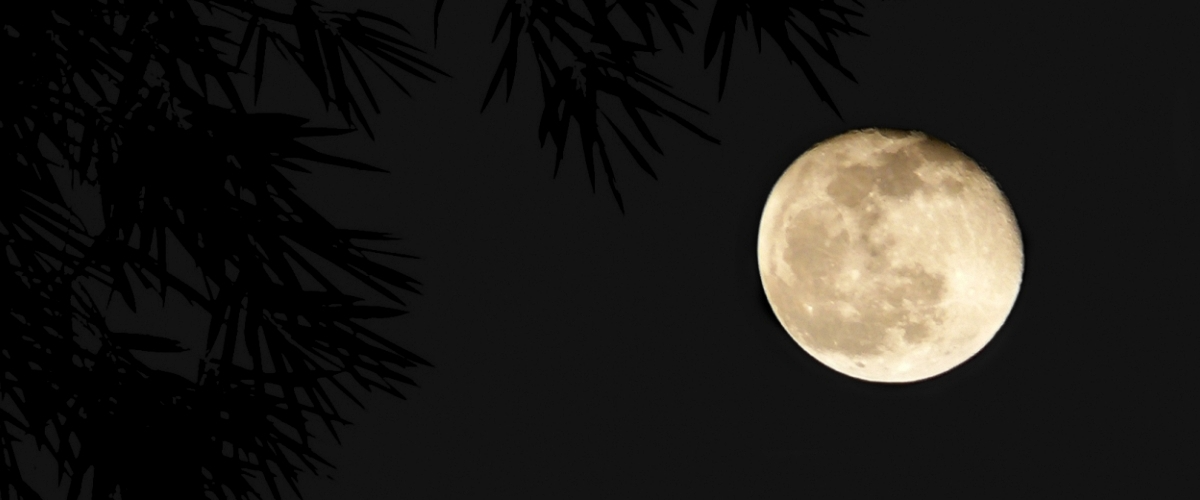

Raag Chandranandan ('Moonstruck') is a modern classic, created by Ustad Ali Akbar Khan in the 1940s. What does the raga's curious tale tell us about the nature of the form?
—Part of Living Traditions: 21 articles for 21st-century Indian classical music
Tracing the history of a raga can lead quickly to the realm of myth. Composers may be heroic, half-legendary figures - Mian Tansen is said to have been able to summon fire with Raag Deepak and rain with Raag Malhar, astounding the onlookers at Emperor Akbar's 16th century durbar (royal court). They can be even the gods themselves - Raag Malkauns is said to have been created by the goddess Parvati to soothe Lord Shiva's tandav dance of destruction.
Retracing the actual sounds of the past is even more of an estimation game. Unlike in the West, compositions go mainly unwritten, meaning the precise patterns of the pre-recording era are largely lost to us. Artists abandon old instruments and modify their tunings, and the fundamentals can drift far from their roots over the centuries.
In the end, few musical facts survive the churn of time. Many ragas are known to have lost their original structures, and some have even swapped names. We will never know where many of the great ragas came from, or what they really sounded like in their early days.
This brings modern creations such as Raag Chandranandan into sharp focus. The fact that you can pinpoint its origin to a specific place and time almost feels unsettling. In the late 1940s, emerging sarod pioneer Ali Akbar Khan sat in an HMV recording studio, and was challenged by the labels boss, eminent musicologist G.N. Joshi, to record something he would not have heard before. Khan recounted the story to percussionist and writer Peter Lavezzoli for his excellent book The Dawn of Indian Music in the West:
"I was still a young man at the time, and I felt that he was insulting my guru, my father, by asking me to play a raga that he had never heard before...But he meant it another way...maybe my father taught me something that [he] hadnt heard. He wanted something unique for the recording. I was angry, but I was also in a good musical mood. So, I was nervous for a second, then I remembered my teacher, my father, and said I was ready to record. I played a few notes, little alap [rhythmless introduction], little gat [melody]..."
Chandranandan is sometimes said to be a blend of four evening ragas - Malkauns, Chandrakauns, Nandakauns and Kaunsi Kanada. But to see its original cut as a diligent, studied interweaving of these existing forms would be to romanticise. Khan explains: "When you blend a raag together you must blend the flavours like punch...you cant taste the individual flavours, but some new taste is there. Like you cant make an animal with the head of a cat, and feet like a bird...it looks funny...and you have no raag."
He elaborates: "I didn't mix the ragas. I took notes from the family of Malkauns, the Kaunsi ragas...It's like coins. One pound, fifty dollars, ten rupees. I can take all of these, go to the bank, and change them into one kind of money. Chandranandan is like that."
Mundane monetary metaphors sit in stark contrast to the divine myths that accompany many other ragas. But these snapshots help to humanise our heroes, reminding us that the stars of the musical pantheon led everyday lives too. Musicians from the distant past were no exception either, but history tends to filter away such details.
Khan certainly doesn't want us to mystify things: "Three minutes and it was finished! When I finished, I didn't like it, but I wanted to listen. I never listen back to my recordings. After I'm finished I just go away. If they say it sounds OK, I just tell them to keep it...But that day I asked to hear it, and it really sounded good."
"They asked me for the name, but I never thought of the name, I never thought about the notes. I just thought of my father and played. So I tried to think of a name, and I said ‘lets go outside and smoke because we couldn't smoke in the studio. We stepped outside, and ‘Chandranandan suddenly came out - 'chandra' means moon, and 'nandan' means beauty."
The impromptu experiment was released as a 78-rpm, and its searching minor-key chromaticism became an instant hit in India. But the ragas emergence into the world soon featured another unexpected twist:
"The audience was shouting for Chandranandan...I told them I had forgotten which notes I used, and that I needed time. I had to buy the record and listen for six months to understand the ascending and descending line. Still sometimes, after a long gap, I have to go through the book."
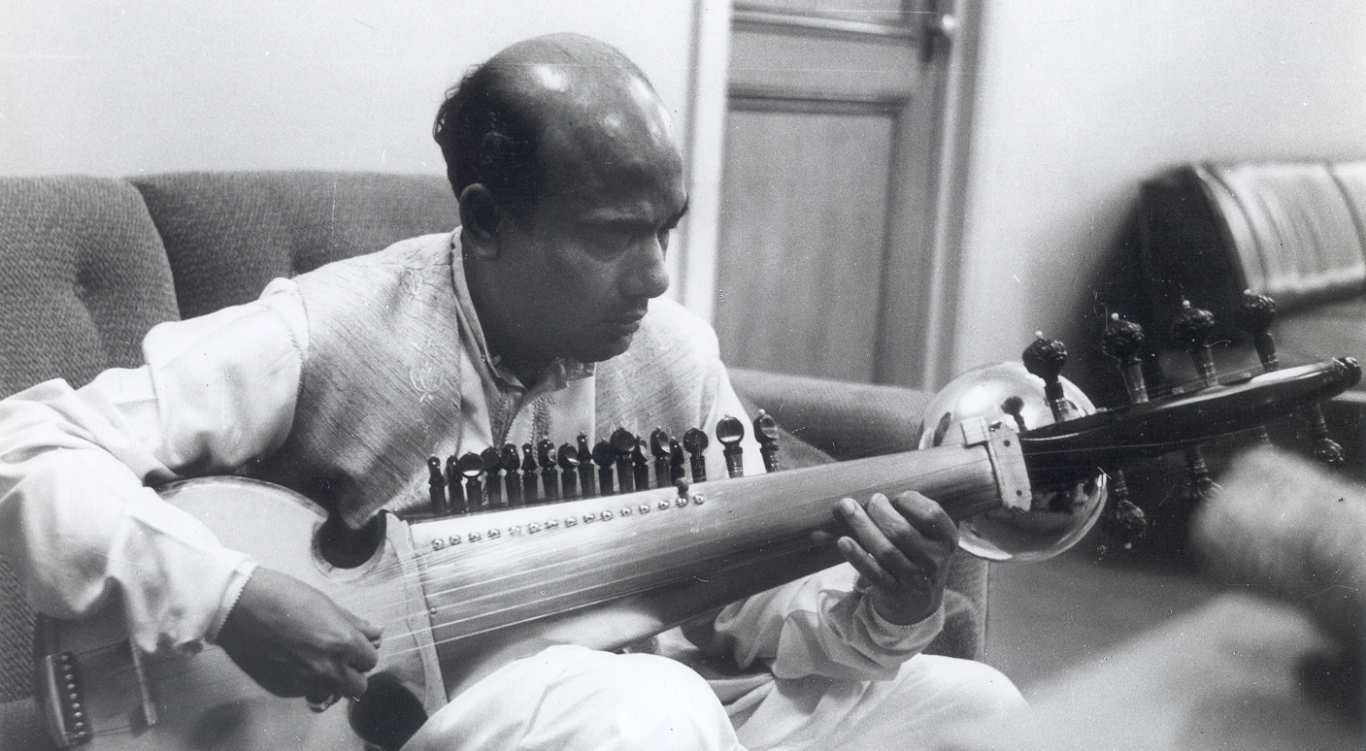
"Three minutes and it was finished! When I finished, I didn't like it..." Photo: Alam Khan
Khans seminal recording of Chandranandan (embedded at the top) did not come until 1964, almost two decades on from its original inception. The ragas strange story leads us to consider the fundamentals of the form. Why was his brief initial take considered to be a raga rather than just a sketch? And how did he become satisfied that the relearned version was tied to the same essence as the first? Examining these questions shines light into the conceptual heart of what we mean by raga.
Chandranandans first cut was only a few minutes long. But we typically think of ragas as inherently detailed, taking years to learn and hours to properly perform. They are deeply encultured phenomena too, commonly associated with specific gods, seasons, or times of day.
Raag Basant is inseparable from the ceremonies of springtime, and Miyan ki Malhar's fluid glides signify the monsoon season. Saraswati is named for the Hindu goddess of music and learning, and Bhairavi for the goddess of destruction.
Many are tied to one or more of the nine rasas, an ancient Sanskrit concept variously translating to ‘juice', ‘taste', ‘essence', or to some, ‘self-luminosity'. Bhimpalasi represents sringara (romantic love) with passionate melodic outpourings, and Malkauns' sparse scale is linked to veeram (heroism, courage), signifying acceptance, determination, and the absence of delusion.
Chandranandan arrived fresh, with none of these cultural signifiers, and its original sketch was too short to define a great deal in musical terms either. So was awarding it instant raga status to downplay these deeper elements, and perhaps even erode the concept in some way? (And did Khan do anything similar by naming it off-the-cuff during a cigarette break?)
Here we should turn to back two millennia to the Natya Sastra. The influential Sanskrit aesthetic treatise describes raga as mood, flavour, that which colours the mind. Each one aims to create detailed emotional effects from within certain formal limits, designed to summon the right blend of tensions in the hands of a master. So, a raga must have the power to leave a distinctive impression - it must specifically entrance.
Chandranandan certainly had this particularity from the start - even a short grainy recording led audiences to call for it by name. Though just a sketch, it spoke to listeners directly, giving complex musical shape to a particular shared mood. A raga is not the sum of its rules - the rules only exist to serve the creation of an overall flavour. This flavour is the true focus.
So for me, the brevity of its initial presentation does not matter very much. Chandranandan not only had the basic sonic hallmarks of Hindustani raga music - single-line melodic development, tabla rhythms, and a tanpura drone - it had a nuanced, distinctive, and immediately recognisable emotional colour too. In the words of its creator, "some new taste is there". Audiences could feel that there was much more behind it, and were eager to peer further in.
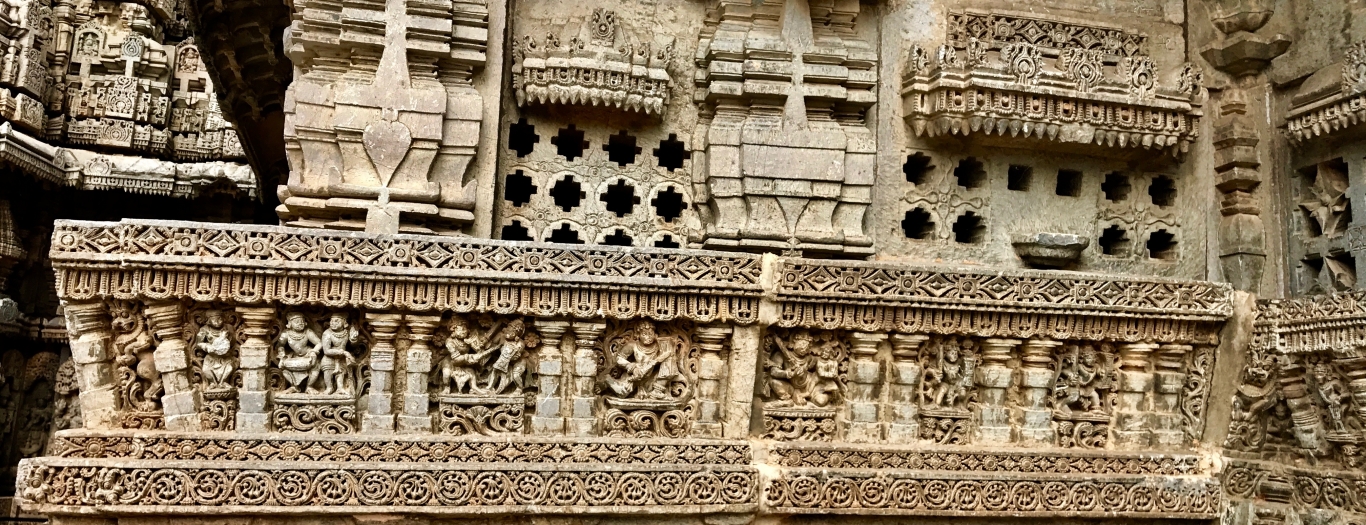
Musicians depicted in 13th century carvings at Karnataka's Keshava temple.
But Khan had to relearn the raga first, and his explorations took time. He was certainly not joking about forgetting it: I knew that the notes were there, but how were they coming? How did they move? That particular mood, those particular notes, I tried to do it again, but it didnt have the same effect.
He elaborates on the challenges faced: I have to go out and buy my record and listen to try and find out the ascending, descending, all these things...that much I could learn by heart and could play - but performing for the public, I had to play for hours, and six minutes is nothing. Therefore I start thinking about that raga, and it took me five years to mature.
Where did it go in the time it was forgotten? Was it in some way lost? A condensed form of it was on a big-selling record, but no scholar would conflate a raga with the sum of its performances. They are abstractions, never defined by a single recording. But for a while Chandranandan existed as a half-sketched studio cut, with only a faded imprint left in the mind of its creator. How did he ensure that his recreation captured the same essence as the original?
Khans approach to resurrecting Chandranandan illuminates how he sees the fundamentals of raga. He connected musical exploration with visual imagination and cultural association, with all three paths allowing him to understand and elaborate different aspects of its new taste. For him, a raga will only reveal its full spectrum of emotional colour when drawing on multiple forms of cognition.
Musically, he worked to unlock and extend the mood of the original, gradually gathering together a set of theoretical principles. He made no secret of his struggles here - five years is a long time for anyone to work on one piece. But the difficulties came not in relearning the melodies of his first cut, a bread-and-butter task for such an intensively ear-trained master. His challenge was to recapture the mood - only then could he reverse-engineer the right musical tools to build on it.
Khan knew that experimenting in the right direction would build the required fluency, and reveal clues about where to go next. But the process was painstaking. He had to be careful not to internally overwrite the mood he was seeking with those he was exploring - perhaps a particular challenge for such an adept improviser, who could fall naturally into making pretty much any collection of notes sound coherent and emotive.
Breakthroughs did not come easy, but they arrived in the end. A finely detailed picture emerges, for example: Shuddha Re [natural 2nd] comes more than shuddha Ni [natural 7th] - shuddha Ni comes only when you go up to the antara side [upper-octave melodic development], and a little bit - a touch - of shuddha Ni in the lower part. Re is strong, but not so strong like other ragas, like Darbari Kanada or Kafi, but it is there.
George Ruckert, one of Khans senior students, published an analysis of the raga in 1996 with input from his guru. He places Chandranandan within Asavari thaat (a parent scale akin to the Western natural minor), and details Khans approach of mixing Kaunsi family ragas, explaining how he looked to their common source for inspiration - Raag Malkauns (read my full article on Malkauns here).
He gives the vadi and samvadi (king and queen notes) as ma and Sa respectively, and offers several possible shapes for the aroha and avroh (ascending and descending patterns). All variants tend to go up in straight lines (e.g. SgmdnS), then descend in spirals (e.g. S RNSR ndPm GmgS ndng S).
But Khan and Ruckert caution against working from the theory forwards: You cant show a raag with just ascending and descending...in the old way they never taught like that. You learned the compositions. Ruckert consequently considers the ragas identity to derive more from specific melodic phrases rather than simple scale progressions, and also notes the challenges posed by the original melodys offbeat resolution. (Im barely scratching the surface here - buy Ruckerts book!).
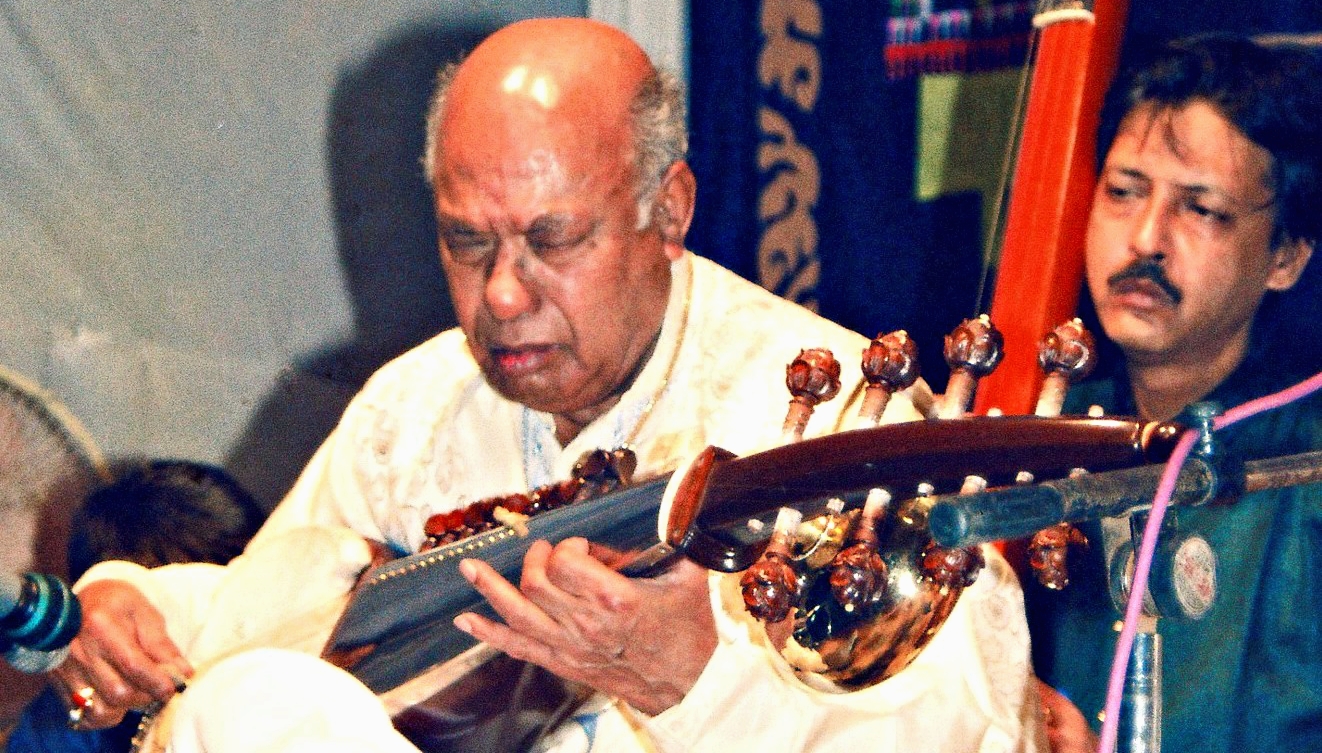
"I just thought of my father and played..."
The Ustad knew he had to develop the ragas emotional landscape to fill out an hour-plus performance. And if a raga is about flavour rather than theory then why not explore it in non-musical ways too? Seen this way, his turn towards visual imagery and Hindu myth is no surprise.
Khan did not hesitate to look beyond his sarod, explaining that visions of Chandranandans name had eventually fed back into its sound: When you look out at the brightness of a million stars on the night of the full moon...full of mystery, endless...that is the mood of this raga. You can even zoom in on some precise points of confluence - he later spoke of the komal Re (flat 2nd) as being hidden late in the melody, like behind a cloud.
The Sanskrit concepts of old established their own gravity too, with Khan ascribing a blend of rasas - karuna (compassion), sringara (love), and veeram (heroism). Explicit focus on these shared reference points will have helped ‘ground the raga within Hindustani musics familiar emotional canon. And in turn, each rasa is associated with a particular colour (in this case, grey, light green, and saffron).
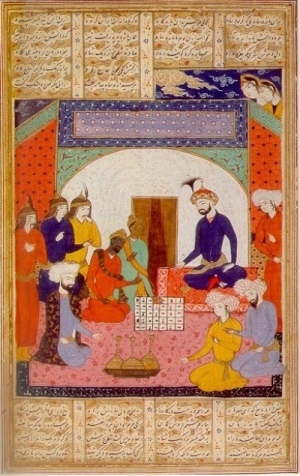
Shatranj illustration (c.14th century)
He turned to metaphors of chess when explaining it to students. His description of how to find expressive freedom within Chandranandans tightly-defined framework hints at a patient, strategic mindset: The ascending and descending are fixed, but in more [in] a curved way...like the game shatranj [an ancient form of chess], you can go in so many ways. The raga you have to play like that...but in the end you dont kill the king!
Conceptualisation occurred on other symbolic and cultural levels. He came to associate its sentiment with Krishna and the gopis [milkmaids] playing with the moon. Krishna is a complex deity, described in some quarters as a god-child, a prankster, a model lover, a divine hero, and the universal supreme being. What is the significance of Khan looking into the ragas melodic tangles and seeing such a nuanced character, replete with looping, clashing narratives?
The threefold nature of his overall strategy demonstrates the interconnectedness of raga. Chandranandan was explored in musical terms - through the trial-and-error process of uncovering guiding principles, which could then be used to summon the basis of the raga at will. It was also nurtured in Khans visual imagination - images of the moon helped him shape its overall sentiment viscerally and directly. And its acquired associations with chess, Krishna, and rasa theory will have left their own imprints too.
But it is perhaps overly Western of me to suggest at neat categorisations like this. In the end, even the most disparate facets of a raga cannot be separated. They all influence the whole, and can only be truly understood in relation to each other.
Chandranandan demonstrates this - despite its relative youth, its sound has already become altered by its own nascent folklore. Khan named the raga after recording it, but its newfound connection to the moon helped him crystallise the musical elements over time. Who knows what it might sound like now if the clouds had been out that night? Or if he had run out of tobacco?
Khan knew intuitively that ragas only come to life when considered as complex cognitive intertwinings, uniting theoretical abstractions with sensory experience and flashes of cultural colour. So his method of reigniting Chandranandan naturally connected the musical, the visual, and the mythic. And in the end, it worked.
Other artists explore in their own ways. Khayal vocal exponent Dr. Ashwini Bhide-Deshpande told me in an interview that she conceptualises ragas in strikingly humanistic terms: They have their own likes, dislikes, and angularities...I want the raga to befriend me too. If Im interested in a raga, I want it to be interested in me.
Benares tabla maestro Pandit Sanju Sahai sometimes visualises talas (rhythm cycles) as characters, telling me that he can see the 14-beat dhamar taal as a warrior moving slowly forward...he proceeds like this as he is riding an elephant. And in the words of sitar genius Ustad Shahid Parvez, Hindustani music is like a great ocean...[my] direction is never pre-planned. It is about the green light.
Some are more abstract. Debasmita Bhattacharya told me she sees ragas as "illusions", and her fellow sarodia Soumik Datta says that elaborating a raga is like spiralling inwards...towards the centre. Others have spoken in terms of walking around an object which can never be seen from all sides at once. Yet more describe the learning process as like placing your hands on a vast sculpture hidden in darkness, gradually building an impression of its overall form.
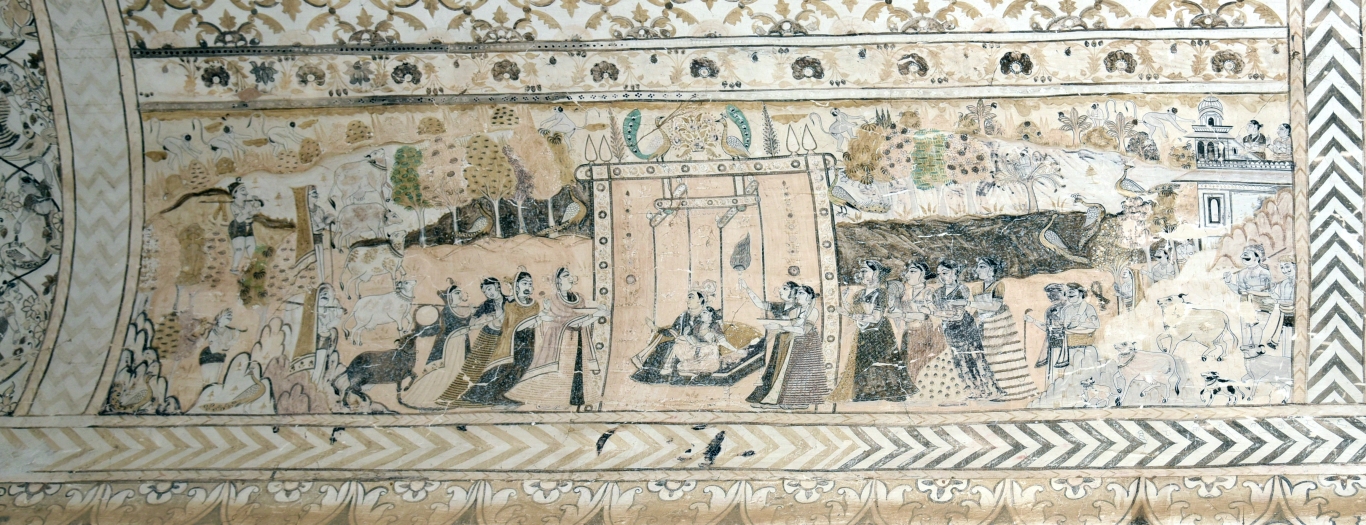
Krishna with the gopis (Madhya Pradesh, c.16th century). Photo: Sagar Das
Far from being static, ragas are improvised for the precise time and place of performance. They may aim to crystallise universal human sentiments, but performers cannot help but set them to their own moods. The resulting musical churn means they are expanded, modified, and reinterpreted over time, as artists search for new territory amidst a shared understanding of certain essences and inviolable boundaries.
Khan formulated Chandranandans original flavour in just a few minutes. But those seeds would bring a rich harvest over the coming decades: like a wine, one or two years old, tastes different after many years of maturing...Chandranandan has more depth now. He would find inspiration in it until his death in 2009, saying whenever I play, I find some new approach.
Ruckert notes nuanced shifts in his gurus performances, for example a growing emphasis on the komal re (flat 2nd) over the years (did he see it emerging from behind the clouds?). Later takes - such as Khans astounding 1981 recording - elevate the music to even greater heights, with elaborate sliding ornaments giving way to sudden bursts of space and fury. Each version brings its own surprises, but all are bound to the same distinct emotional core (in Khans words, the same liquid in the bottle).
Chandranandans lunar focus also helped inspire, in turn, the impromptu creation of another brand new raga. Khan went to the White House to receive an award in 1997, and was only given ten minutes to perform. Before taking the stage he stood on the balcony of the Ben Franklin room, staring at the moon, and adapted Chandranandans ideas into Raag Chandra Dhani (‘moon over the capital) for the occasion.
Others have attempted to scale the raga's heights too, although tabla scholar Dr. Aneesh Pradhan considers that Khans renditions have been so captivating that most others who have sought to present the raga have seldom managed to break away from his idiomatic expression. Im inclined to agree, but nevertheless, some musicians have hit the mark within this space (n.b. there's a playlist at the end).
I recently witnessed Ken Zuckerman, also one of Khans senior students, play the raga live in London to superb effect - a condensed version is on his album Nature of Ragas - Ragas of Nature. Indian slide guitar pioneer Pandit Brij Bhushan Kabra also learned the raga directly from its creator, and uses his guitars tenser strings to inject fluid hints of melodic instability.
After this article first came out, a reader - Satya Pesh - emailed me, persuasively pointing out that it had been an oversight on my part to omit the work of Pandit Rajeev Taranath, another senior disciple of the great Ustad. I somehow didn't come across his Chandranandan recordings until now, and after listening I wholeheartedly agree. So, as are the joys of online writing...here is Taranath's mellifluous rendition, one of the very best, filmed live for Pandit Hariprasad Chaurasia's Vrindaban Gurukul project (any other feedback/comments/disagreements: george@ragajunglism.org)
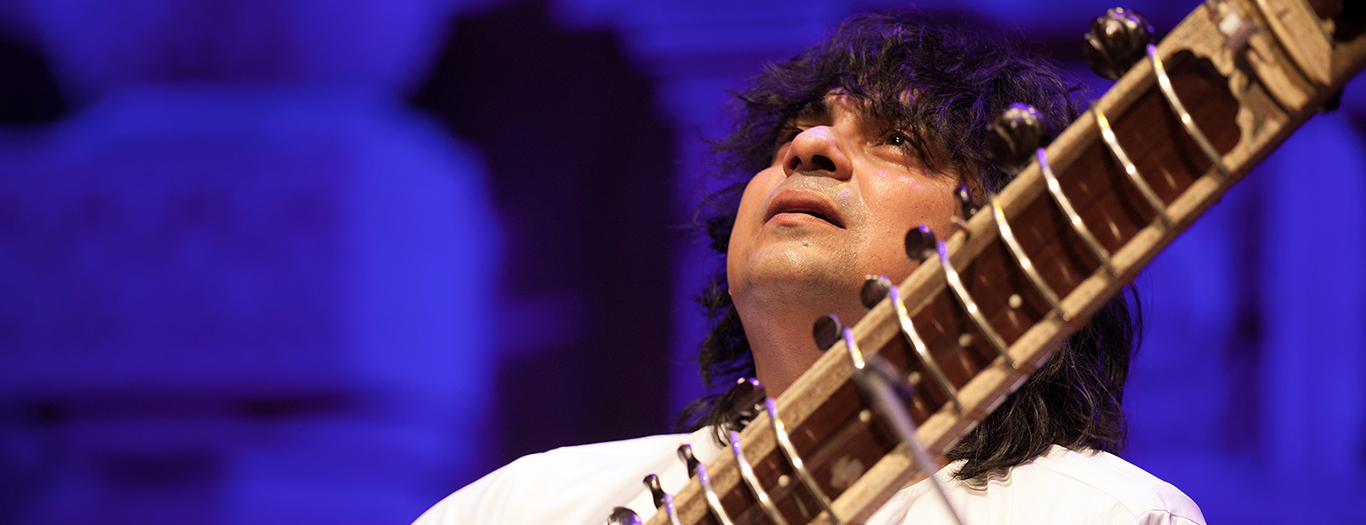
Niladri Kumar has reworked Khan's melodic material. Photo: Rehmat Rayatt
Sitarist Pandit Krishna Bhatt studied with Khan and other greats from the Senia-Maihar gharana (regional tradition), including Pandits Ravi Shankar and Nikhil Banerjee. His deeply learned approach to Chandranandan begins with patience but eventually builds to a climax of aggressive, angular lines. And Banerjee collaborated with the Ustad himself, recording a well-balanced jugalbandi duet.
Vidushi Zarin Sharma was inspired to take up the sarod after witnessing Khan play a duet with Ravi Shankar at the age of six. Her version of Chandranandan is sparse but effective, full of slow elaboration and melodic echo. Sitarist Niladri Kumar places the ragas tones in a fusion setting with surprising nuance, but ends up unravelling many of its characteristically introverted tensions in the process.
Chandranandans strange journey tempts us to follow further lines of speculative inquiry. Imagine that we soon unearth ancient musical treatises which detail the theoretical characteristics of long-forgotten ragas. How much could we really empathise with the precise emotional colours of our distant ancestors?
And if modern musicians took up these forms again then would we say that the ragas had stopped existing for the intervening centuries? To me it doesnt sit right to say that they had really vanished. But does this mean that a raga can exist independently of human experience? Is this why many see them as being sustained in the minds of the gods?
In the end, the definitional edges of complex aesthetic forms will always be frayed, and fresh questions will inevitably arise at each turn. When two musical lineages take an emerging raga in contrasting directions then how do they first come be seen as separate? And if ragas are about universal sentiments then are they more created or discovered?
Some artists talk about them as if they were ‘always there in the fabric of nature, just waiting to be unearthed. But in the case of Chandranandan this natural inevitability seems a fair few steps too far. Who knows what would have been created in its place if Khan had been in a different mood that day? Would recording it after a coffee break have added an extra tinge of nervous excitement?
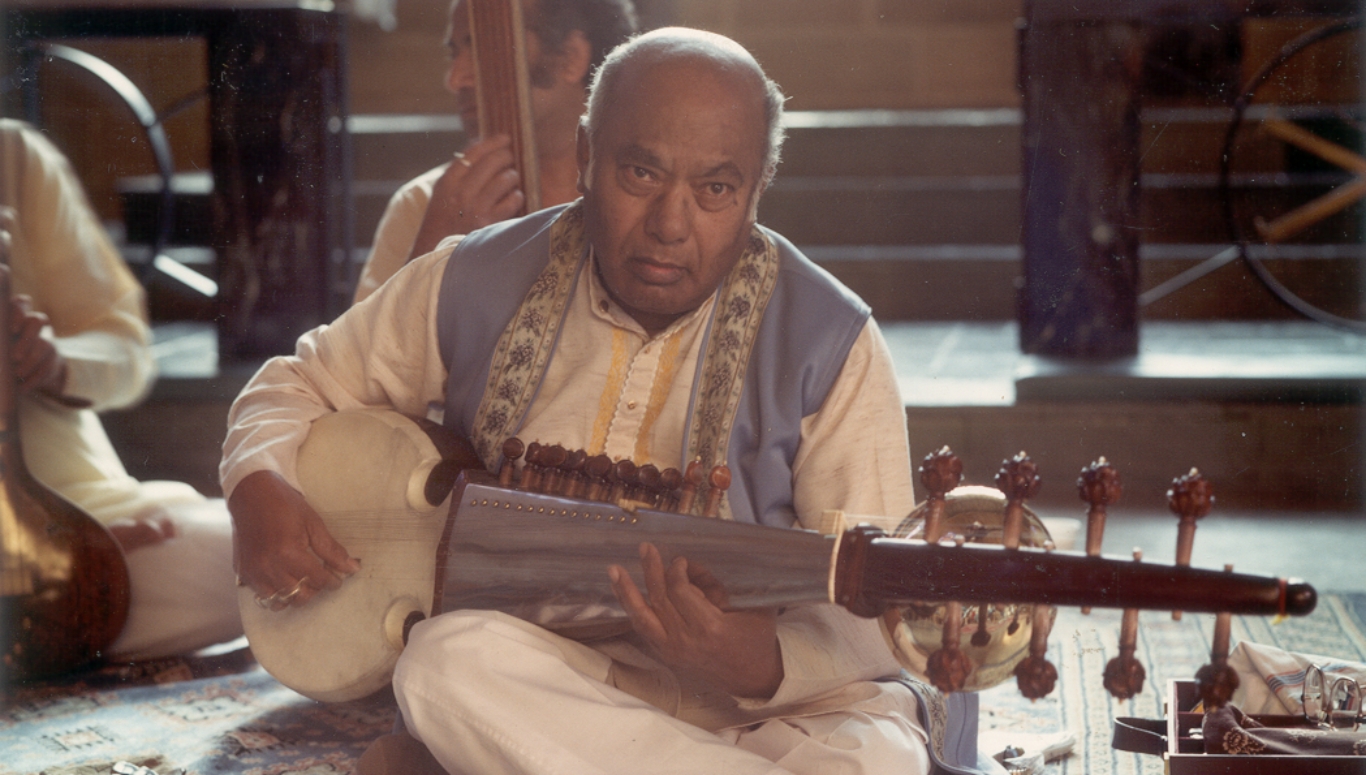
"A million stars on the night of the full moon". Photo: Alam Khan
Violinist Yehudi Menuhin called Ali Akbar Khan an absolute genius...the greatest musician in the world. In his youth he practiced for up to 18 hours a day, and his boundless mastery placed the sarod at the forefront of modern Hindustani music. Listening to Chandranandan is a humbling experience, showcasing near-unattainable heights of musicianship.
Its curious tale not only illuminates some fundamentals of raga. It also helps to bridge this divide - improvised, hastily named, forgotten, and then relearned with difficulty. Most of us can relate to unpredictable mess more easily than divine visitations. What mortal wants to believe that creativity is the rarefied preserve of the gods?
• George Howlett is a London-based musician and writer, specialising in jazz, rhythm, Indian classical, and global improvised music. Many thanks to Alam Khan, Ali Akbars son and student, for his input to this article - particularly for sharing invaluable material from the familys archives. May this article serve as a dedication to the Ustads legacy.
Darbar believes in the power of Indian classical music to stir, thrill, and inspire. Explore our YouTube channel, or subscribe to the Darbar Concert Hall to watch extended festival performances, talk and documentaries in pristine HD and UHD quality.
VR360 Festival | Darbar brings Indian classical music into the realm of virtual reality. We see VR as a way of...
Read More 
The Patiala khayal superstar discusses her unique cultural heritage, the power of physical expression, and how to...
Read More 
Exploring ten strange, beautiful instruments from India's classical traditions. By George Howlett | Part of Living...
Read More 
The beginner's guide to Indian classical music. Whether you’re completely new to raga music or just need a refresher, we’ve put together this brief overview of all things raga music to help you feel at ease when visiting one of our concerts or watch our videos on our YouTube or our Darbar Concert Hall.
Keep up to date with the latest news, events, music and musings across our social channels
For hundreds more clips and shorts, vist our YT page here 